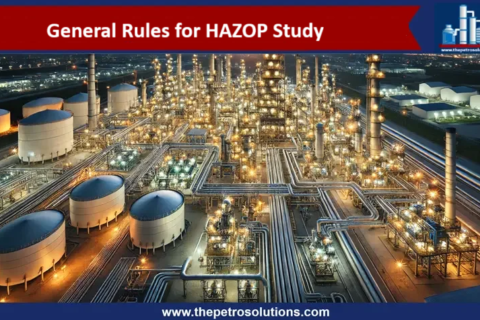Temperature excursion or temperature runaway is the abnormal process condition at which catalyst bed temperatures go high beyond the normal operating limit on account of uncontrolled hydrocracking reactions. During a temperature runaway condition, highly exothermic cracking reactions may take place. Temperature runaway is a very serious, unsafe situation in hydroprocessing units since extremely high temperatures can be generated within a short period of time. Consequently, equipment may exceed the design temperature and can cause catastrophic damage to the catalyst and reactor.
The consequences of a hydrocracking catalyst temperature runaway can be catastrophic starting from coke lay down to the explosion of the reactor. The effects include coking, catalyst damage by sintering, reactor metallurgy effects, reactor internal failure, sudden pressure rise of the system, leakage from the flanges, etc. High localized temperatures can lead to increased coking and possibly even fusion of the catalyst.
Indications of Temperature Runaway
In the course of normal operations with constant reactor feed, conversion, and quench control, hydroprocessing reactor temperatures remain stable and do not rise unexpectedly. But unforeseen situations may always exist that may lead to sudden emergencies that should be recognized and acted upon immediately.
- Sudden temperature rise about 5~15 oC/minute on catalyst beds, deviating from the normal operating conditions. This can be noticed from the reactor high temperatures alarms.
- Temperature rise across the catalyst bed (DT) more than the operating although design temperature is higher than the increased temperature. Design differential temperature across amorphous hydrocracking catalysts can be up to 40 oC.
- The reactor temperature has started to rise and continues to increase by 28 oC above normal operating.
- Radial spread temperature increases more than the design i.e. ~20 oC.
Causes of Temperature Runaway in Hydroprocessing Reactor
- The low-flow areas in the reactor due to the maldistribution of flow streams can exhibit very unstable temperature control and channeling in the catalyst bed. This can be seen by a temperature hot spot in a catalyst bed and in extreme cases generating a local temperature runaway which can go well over 500 oC. This situation may arise on account of feed flow rate below turndown, reactor internals failures, and improper catalyst loading. Because of the potential problems due to the maldistribution of flow in the catalyst bed, it is extremely important that the catalyst be loaded properly with a dense loading method.
- Loss of quench gas will result in abrupt temperature increment across the catalyst bed. Quench hydrogen gas in hydroprocessing reactors is utilized to control the temperature of the next catalyst bed by mixing the previous bed effluent with fresh gas and dispersing evenly over the top of the catalyst bed.
- A significant reduction in space velocity over the catalyst is discussed in point 1.
- A fresh sulfided catalyst is highly active and it is the most critical time when very special care should be taken to control the reactor temperatures. Any careless action by the Boardman may result in temperature upset across the reactor.
- Uncontrolled firing at the furnace will rise the reactor feed temperature and will cause thermal excursion in the reactor.
- An unexpected drop in liquid or gas feed rate will increase the temperature of reactor feed because both feeds were also working as heat sink in the hydrotreating reaction environment.
- Sudden change in feed quality. A high concentration of Olefins or a high flow rate of cracked unsaturated feedstock will result in high reaction rates and high heat generation across the hydrotreating reactor.
- The presence of higher concentrations of CO and CO2 in the reactor feed may result in thermal excursion due to highly exothermic methanation reactions. It should not be built up in the reactor environment. Further, their presence will also affect the hydrotreating and hydrocracking reactions.
Guidelines to Avoid Temperature Runaway
For hydroprocessing reactions triangle requires hydrogen, hydrocarbon feed, and catalyst. Breaking the link in the triangle by stopping any of the components will stop the hydroprocessing reactions. As it is not possible to remove the catalyst, so it should be removing either hydrogen or hydrocarbon immediately to stop the temperature excursion situation. The quickest way to stop the runaways is to remove the feed from the unit and to cool the catalyst with recycle gas.

- Do not exceed the design delta T (35~40 C) on anyone catalyst bed for hydrotreating catalyst.
- When changing the feed rate, rise the feed rate first, then increase catalyst temperature. On contrary, decrease catalyst temperature first, then reduce feed rate.
- Temperature rise across the catalyst should always be gradual and smooth. The temperature increase rate depends upon the catalyst age and the severity of the operation. Fresh catalyst is very active and sensitive to temperature, so increase the temperature in small increments maximum of 2~4 oC per hour.
- If any unexpected reduction in the liquid or gas feed flows is observed, immediately reduce reactor inlet temperatures. Loss of any of the feed streams flowing through the reactor will result in lower heat removal capability and can lead to a temperature runaway.
- As temperature rise in any of the catalyst, beds are observed then immediately, reduce the inlet temperature of the bed. Also, watch and reduce the temperature of downstream beds because heatwaves generated in one bed may transfer to the downstream beds as well.
- If the temperatures rise across the bed can not be controlled by increasing the quench, then decrease the reactor inlet temperature by decreasing the firing of the feed heater. But if the bed temperature still continues to rise, then stop the firing in the reactor and stop the liquid feed if temperatures do not come under control.
- If the catalyst bed temperatures have increased 28 oC above the normal operating and continue to rise despite the above corrective actions, then activate the emergency depressuring system (EDS). The EDS will automatically, stop the feed to the reactor, firing in the heater while recycle gas will continue to circulate through the reactor to cool the catalyst beds. Normally, after EDS operation, the reactor temperatures stop rising as the recycle gas continues to pass through.
- As the EDS has been operated then it should not be stopped too soon to hold the system pressure and save the unit restart time. This is a wrong approach that can result in another thermal runaway when restarting the unit with a hot and insufficiently cooled catalyst bed with feed remaining on the catalyst pores.
- Moreover, feed exchangers can be bypassed to avoid interaction with reactor effluent and more cool gas will go directly to the reactor.
- These cooling actions can be continued until the bed temperatures are under control and have been brought back below the normal operating temperatures.
- Finally, after the thermal excursion has been under control, then the reactor should be purged with Nitrogen, to remove any of the remaining contaminates in the reactor, otherwise, there are chances of another temperature runaway when the unit is restarted.
- In case of quench gas failure, reduce the reactor inlet temperature to reduce the catalyst bed temperature within the operating conditions. The unit load can be immediately reduced and recycle gas flow rate can be increased to cool the reactor. Further, if the temperature of a specific bed can not drop down and continues to increase despite the control action then stop the liquid feed or press the emergency depressuring.
- The last but most important point is that the operation team should identify all the possible conditions of thermal runaway and prepare the procedures to act accordingly. The operating staff should also be trained to respond at once because most of the reasons for the excursion can be attributed to operation errors.
- Limit the concentration of olefins and cracked stock in the feed by continuously monitoring the feedstock quality.
- Do not bypass the emergency depressurization system and high-temperature alarms on the catalyst.
For further information, discussion and queries please comment in the box below or contact at admin@ or follow us on Facebook & LinkedIn.
Certified Functional Safety Professional (FSP, TÜV SÜD), Certified HAZOP & PHA Leader, LOPA Practitioner, and Specialist in SIL Verification & Functional Safety Lifecycle, with 18 years of professional experience in Plant Operations and Process Safety across Petroleum Refining and Fertilizer Complexes.
- Nasir Hussainhttps://thepetrosolutions.com/author/admin/
- Nasir Hussainhttps://thepetrosolutions.com/author/admin/
- Nasir Hussainhttps://thepetrosolutions.com/author/admin/
- Nasir Hussainhttps://thepetrosolutions.com/author/admin/







3 thoughts on “Avoiding Temperature Runaway in Hydroprocessing Reactors”
Concise description of process which includes experience and theoretical knowledge both.